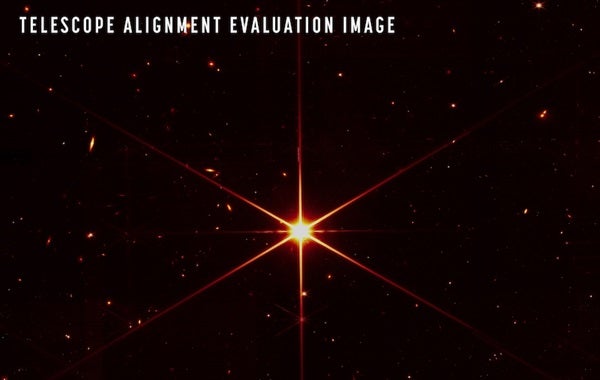In early February, NASA engineers began to remotely align the 18 hexagonal segments of the James Webb Space Telescope’s primary mirror, which had been folded away for launch. The goal of this meticulous, three-month-long process is to perfectly position the mirror segments relative to each other, creating a single, smooth, 6.5-meter-wide surface that can gather and focus light from the distant cosmos.
You may recall earlier snapshots that marked previous milestones. For example, the second of seven milestones was punctuated with a shot taken before the mirrors were fully aligned; it featured multiple images of a single star. Now, NASA has announced the fifth major alignment milestone is complete. Called fine phasing, this step helped to identify and correct small differences between individual mirror segments to bring the infrared universe into sharp, clear focus.
And it worked: JWST recently snapped the infrared test image above — which focuses on the star 2MASS J17554042+6551277 — using its Near Infrared Camera (NIRCam). Not only is the star a single, clear point of light, but the telescope’s optics are so sensitive that fainter background stars, and even galaxies, are clearly visible. (Note that the image was obtained using a red filter to achieve better contrast.)
This beautiful stellar portrait — the sharpest infrared shot ever taken from space — verifies the telescope’s optics are performing optimally. In fact, they’re working so well that engineers are now confident the JWST will not only meet, but in many cases exceed, its science goals.
Two more major steps remain to complete the alignment of JWST’s mirror. It is now perfectly set up for the field of view of NIRCam. But the mirror still must be aligned for the other instruments’ fields of view — which may be larger or smaller, or differently shaped. Finally, the segments will again be checked for minuscule misalignments and any lingering issues will be smoothed away. Once complete, hopefully by early May, the team plans to spend two months prepping the instruments for science.
If all goes well, NASA expects that by the summer we will be awash in stunning new views of the universe. These portraits will not only reveal the surreal beauty of the cosmos in crisp detail, they will transport us back to a time when the very first galaxies were just starting to shape the universe into the place we see today.










